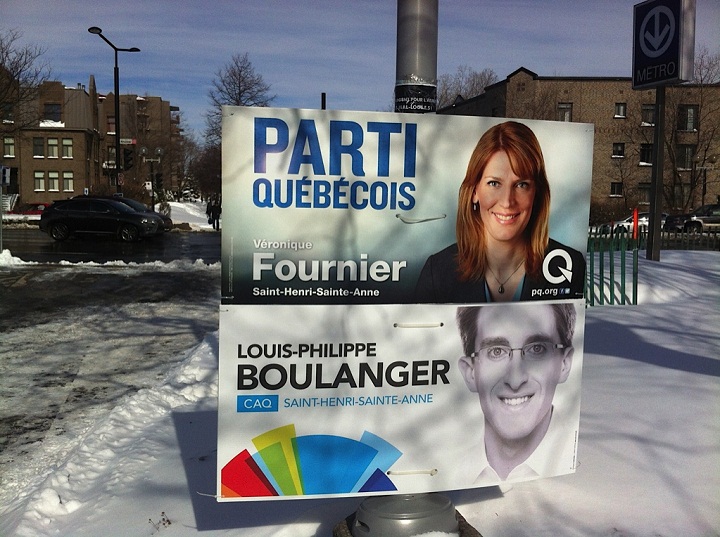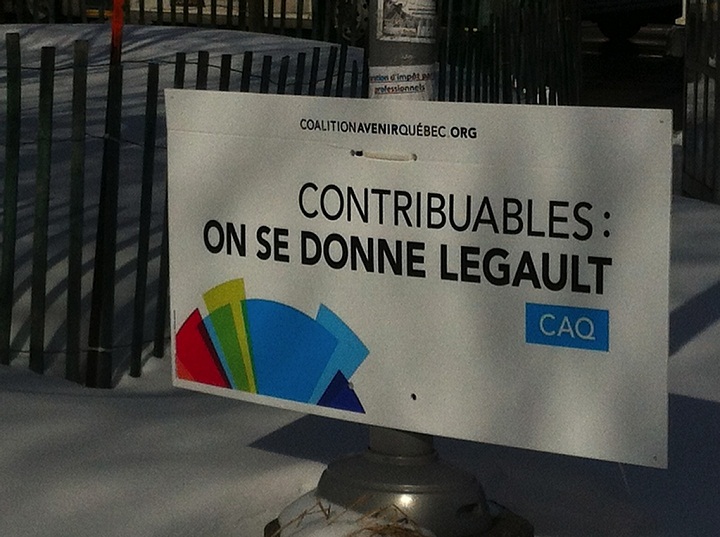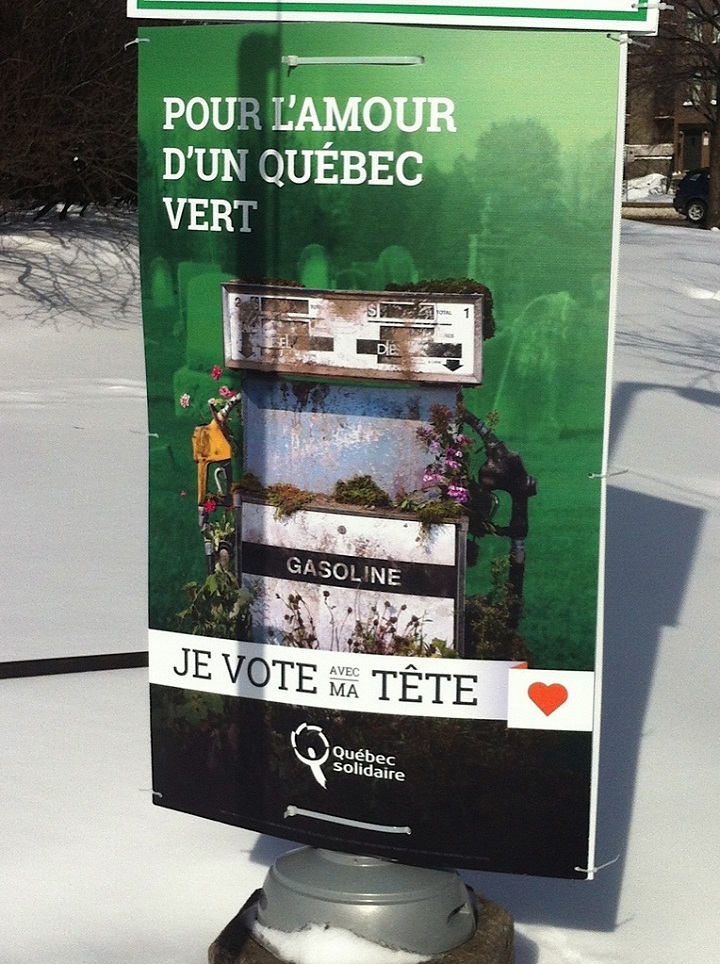MONTREAL – For the third time in the past eighteen months, Montrealers will be going to the polls on April 7.

In perhaps the most depressing election in recent memory, Quebecers will be asked to decide between the scandal-plagued Liberals, whom it seems we just finished kicking out of office, and a Parti Quebecois government, which has turned breaking campaign promises into an art form during their short stint in government.
But while the top line battle plays out between the heavyweights of Quebec politics, the smaller parties struggle to be noticed.
The Coalition Avenir Quebec, staring oblivion in the face, want to give us Legault. Unfortunately, we don’t seem to want him and their returns policy remains murky.
WATCH: Quebec political parties unveil TV ads
Quebec Solidaire must be wondering anew about the existence of a higher power, and if such a power is indeed on their side, after the entry of Pierre Karl Peladeau into the fray.
While the full effect of his candidacy remains to be seen, it’s no less than a godsend for a progressive party which is only really competitive in Montreal. In the Eastern reaches of the island, they can expect an influx of angry Pequistes, no longer willing to hold their nose and vote for Peladeau’s brave new PQ.
But as much fun as it is to sit here and gripe about the dismal choices we face, it’s far more fun to set aside politics for a moment and take a look at the offerings of the various parties through a different lens.
The first sign of an election is always the signs which crop up on hydro poles and light posts from one end of the city to the other.
So we thought it would be fun to take a look at what the various parties are polluting our fair streets with, and grade them on the effectiveness of their visual design and appeal.
These rankings are entirely subjective, and represent my opinions alone. For this exercise I’ll be ranking all street signs put up by a party as parts of a greater whole. The parties are listed here in order of finish in the 2012 election.
Parti Quebecois: B+
The visual rhetoric of the PQ has been miles ahead of their Liberal competitors in this campaign, and their signs are no exception.
Similar in conception to those of the CAQ, they make more effective use of the negative space around their candidates, and by introducing grey on a gradient, avoid leaving large white areas to be covered by graffiti and road grime.
Unlike the CAQ and Quebec Solidaire, the PQ opted not to go with a slogan sign, and theirs are restricted to conventional 4×4 signs featuring Premier Pauline Marois and 2×4 signs featuring the local candidate.
The slogan, “Déterminée,” is a solid, if unspectacular, choice. The PQ want to project competence and show Marois as a leader.
Their grey, gritty signs succeed on both counts.
It isn’t rocket science, nor is it particularly innovative, but it’s a solid example of conventional campaign signs done well. That said, distribution leaves something to be desired. In much of Montreal, they have been slow to place their signs.
Liberals: F
If someone had hired me to come up with the worst, least effective campaign signs imaginable, I think they’d have looked a lot like the hot mess that is the Liberal signs.
Their size is a weird hybrid between the large 2×4 and 4×4 signs designed to be visible to drivers, and the smaller “chandelles” designed to catch the eye of pedestrian traffic.
In practical terms, this means they’re too small to be seen from cars, but often placed too high to be visible to pedestrians.
Speaking of visibility, the colour scheme is deathly dark, and the posters all but invisible once the sun sets.
This problem is particularly pronounced with dark-skinned candidates, who simply disappear into the dark blue background of their signs. Someone was asleep at the switch for them to fail so miserably at the single, most important function of campaign signs.
Meanwhile, the slogan, “On s’occupe des vraies affaires” (We’ll take care of the real issues), may sound good to English-speaking voters, but as Journal de Montreal columnist Lise Ravary has pointed out, it’s most often used by French-speaking Quebecers when referring to anything but serious business.
How do you not realize your slogan is a well-known joke among your target audience?
I have yet to see any leader signs, and I travel large swaths of Montreal on a daily basis. Either they don’t have any, which would compound the disastrous failure of their candidate signs, or they have been unable to allocate the resources to get them up on the streets.
I suspect the answer might be the latter, given the story which came out this week of the Liberals paying two men thousands of dollars to put up a hundred signs. Apparently the men were able to negotiate such a favourable rate due to the desperation of the Liberal campaign. Other parties typically rely on their volunteer base, rather than paid labour, to put up signs.
So to recap: the design is a disastrous failure, the size is incomprehensible, the distribution is weak and the impact is negligible. If the PLQ win this election it will be despite their signs, not because of them.
Coalition Avenir Quebec: C
When it comes to the CAQ, it’s really a tale of two signs.
The candidate signs, brilliant white against the snow, come in both 2×4 and 4×4 varieties. They’re clean and simple, and have candidate photos in grayscale to leave all the colour to the gorgeous rainbow logo.
While the ample white space is pretty now, it will make an appealing target for teens with Sharpies, and will inevitably become grey and dingy with the accumulation of road grime.
If these were their only signs, their grade would be significantly higher. Unfortunately, this isn’t the case.
Sprouting up all over town are another variety, 2×4 signs emblazoned with the absurd slogan “Contribuables: on se donne Legault” (Taxpayers: We give you Legault).
These signs somehow manage not to include a picture of the man they are offering to Quebecers, and are text-heavy eyesores.
Then there’s the slogan itself, which lends itself to ridicule, and really doesn’t make strategic sense given that Legault’s personal popularity is not particularly high.
These epic failures are deserving of an F, but the overall grade is boosted by the solid candidate signs.
Also worth noting is the fact that the CAQ have been moderately efficient at placing their signs and I’ve seen them in all parts of town.
Quebec Solidaire: A
Before moving into journalism, I spent many years working on political campaigns, often overseeing the sign effort for parties like the NDP and Projet Montreal.
To my jaded eye, I think Quebec Solidaire have set a new bar for campaign signs, one which other parties will be aiming for in future campaigns.
Before we get to content, there’s the unprecedented size, which I estimate at 2.5×4.5 feet, and the comprehensive coverage.
From Park-Ex to Berri, St. Henri to Hochelaga, no party has more signs on the street than QS.
The three flavours of issue signs (inequality, environment and sovereignty) are easily scanned by passing drivers and transmit complex ideas in a single visual.
These are complemented by local candidate signs and full-sized leader signs featuring Amir Khadir and Françoise David. But confusingly, not Andres Fontecilla, who replaced Khadir as co-spokesperson last year. One assumes internal numbers show Khadir is more popular than his replacement.
The signs contain not one but two slogans, and if there is a criticism to be made of them it is that they are too busy.
The top part of the leader signs reads “Pour l’amour d’un Quebec solidaire” (For the love of a Quebec ‘solidaire’), local candidate signs replace Quebec with the name of their riding, and issue signs speak of a more just, more green and more free Quebec.
Meanwhile the main slogan, carried on a banner draped across the bottom of all signs, is ‘Votons avec notre tête’ (Let’s vote with our head), followed by a heart.
This is, of course, a reference to the dismissal of their party as a gang of dreamers without a grasp of the political realities of the day.
This slogan takes on the main attack of the party’s rivals and turns it into a positive, arguing that their policies are both emotionally and intellectually appealing.
I can’t imagine anyone could dispute the fact that QS is the clear winner of the sign war.
Option Nationale: C-
I feel for ON, I really do. Their founder and patron saint, Jean-Martin Aussant, has departed and left the fledgling party he built in his image struggling to define their identity.
With support hovering around one per cent and no sitting MNAs, it’s easy to imagine that this will be the last election for the ‘sovereignty-in-a-hurry’ party.
As for posters, if they have candidate signs, I haven’t seen them.
All that has popped up around Montreal are leader signs featuring new party chief Sol Zanetti, his shirt sleeves rolled up and every bone in his body straining to convey the idea that it’s time to get to work.
Depressingly enough, they feel the need to identify him as the leader of the party in a caption.
The slogan, “Réveiller le courage” (Awaken the courage) is quite good, and appropriate to their mission of immediately tackling the issue of sovereignty.
But really, a party in their position needs to be a bit bolder and do more to attract attention than they have with these posters.
Green Party: D-
The Greens, under new leader Alex Tyrell, are to be commended for putting up more signs, and taking clearer positions, than I have seen them do before.
Unfortunately for them, that’s where the plaudits end.
While I’m happy to see a party, any party, provide an eco-socialist option to federalists who support free education, strict environmental protections and more equal taxation, but are unable to bring themselves to vote for a sovereigntist party like Quebec Solidaire – the execution of these posters leaves a lot to be desired.
The Green Party signs are, and there’s really no way to put this nicely, an eyesore.
They look like they were designed by a grade-schooler, feature far more text than can be read from a car, or indeed while walking past, and bring new meaning to the term busy.
Not only do they print out their web address (you folks know we can Google you, right?), but the web addresses for their Twitter and Facebook accounts as well.
For future reference, we assume the Greens have accounts on those platforms, and if we want to find them, we know how to use the search function.
The three together take up nearly a quarter of their signs’ surface.
Given that their campaign saw both Campaign Director Peter Deslauriers and Director of Communications Simon Delorme resign their positions in the first week, reportedly as a result of disputes with the party’s embattled leader, I suppose it shouldn’t be a surprise that their communications strategy leaves something to be desired.
What do you think? Whose signs do you like? Which ones make your eyeballs bleed? Let us know in the comments below.
Ethan Cox is a Montreal-based political commentator and senior partner with CauseComms: Communications for the Common Good. He writes about Quebec and national political issues for Global News, The National Post, Toronto Star and other news outlets, and is also a regular analyst and host on radio with CJAD 800 and on television with CTV.










Comments